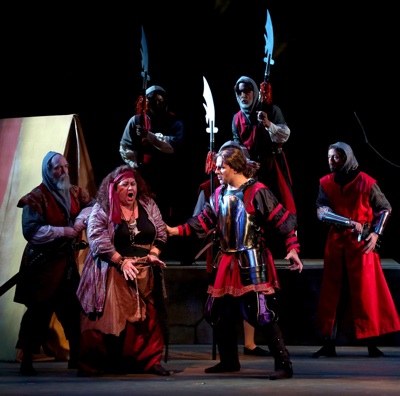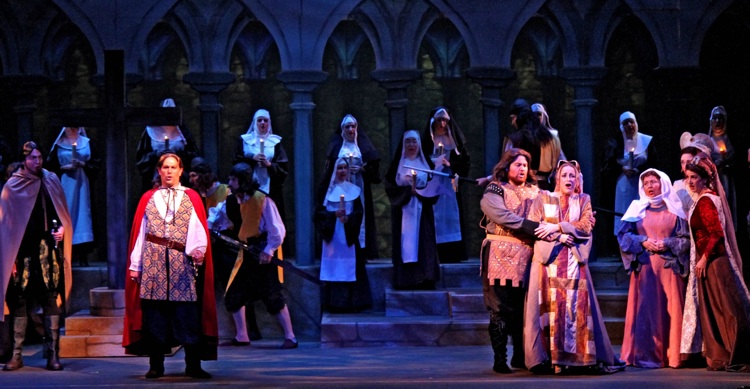Great cast, crazy plot… and that’s opera!
A strong cast lit up the stage last Friday in Palo Alto’s Lucie Stern Theater, where the West Bay Opera launched Verdi’s triumphant Il trovatore. While two or three top talents can carry a show, the presence of five exceptionally strong singers made this a night to savor.
Verdi based his “Troubadour” on a tale of fourteenth century Spain that was so gripping and twisted that the audience staggered out after four acts, looking pleased but a little shaken.
José Luis Moscovich, the artistic director and conductor of West Bay Opera, took a moment to introduce the opera, describing the insularity of the Spanish culture dating from just after the expulsion of the Moors, and then likened it to present day Ebola scares. This was not far off, with half of Europe dying of Bubonic Plague between 1350 and 1400. With the Count di Luna representing the Spanish gentry, wandering gypsies as a disease vector and burnings at the stake as sterile technique, one could certainly stir up some paranoia. But then came a love triangle that would make the Center for Disease Control throw in the towel!
 With Moscovich in the pit, the timpani set a chilling atmosphere with distant thunder that swelled and died away. Horns took up the tension and the curtain rose on an army of singers stuffed on the small stage, frozen in postcard tableau. As the overture stilled, they began to break pose and Christopher Filipowicz made a fine entrance as Ferrando, describing a sordid back-story of kidnap and infanticide… and burning at the stake, of course! This promising bass baritone pulled his notes from deep in his diaphragm like the coughing roar of a young lion, and it would be easy to mistake him for the lead.
With Moscovich in the pit, the timpani set a chilling atmosphere with distant thunder that swelled and died away. Horns took up the tension and the curtain rose on an army of singers stuffed on the small stage, frozen in postcard tableau. As the overture stilled, they began to break pose and Christopher Filipowicz made a fine entrance as Ferrando, describing a sordid back-story of kidnap and infanticide… and burning at the stake, of course! This promising bass baritone pulled his notes from deep in his diaphragm like the coughing roar of a young lion, and it would be easy to mistake him for the lead.
But then Krassen Karagiovoz entered as the Count, a baritone with smooth depths and raging jealousies, and the action was off like a shot. His rival in arms and love, Manrico, was sung by James Callon in an exceptionally bright tenor, with arias that included two moving duets with the gypsy who raised him, a stirring call to arms (with much flashing steel and manly men), and some off-stage lines where his voice lofted across us in a moment of beauty unlike any other.
Their love object, Leonora, was sung by soprano Cynthia Clayton with a sense of timing that added to her devastating low register, a voice on the edge of breaking with fat vulnerability. Her opposite number, dramatic mezzo Patrice Houston, inhabited the role of Azucena with enormous vocal and emotional range. This was a huge role with punishing arpeggios and several great arias, including a low and fiendishly acrobatic solo to the gypsy village.
The opening was one week after Verdi’s Un Ballo in Maschera appeared at the San Francisco Opera. Two works by the gifted Giuseppe in such short order were a feast of riches, giving insight into his genius for orchestrating a mood. There were also surprising plot parallels, as both operas had love triangles and weepy love objects – musically inspiring but tough acts for self-respecting sopranos. And in both, the real drama turned on powerful women: Un Ballo had Ulrike, a seer chillingly portrayed by the great Dolora Zajick, while Il trovatore revolved around Azucena’s devastating history and inner torment.
The two productions, however, were classes apart.
In San Francisco we had lavish sets, a fabled orchestra and top names. But despite the glitter these were presented in a hall so outsized that there was little room for nuance. West Bay’s production, on the other hand, immersed us in the drama from the start with an intimate hall and five young singers who had both vocal chops and flashes of vitality.
In one trio, Houston, Callon and Clayton delivered a soft purity – a display of control and pure ear – for one of the sweet spots of the night. And it would have been inaudible at SFO!
As usual for the shoe-string opera company, they were abetted by spot-on musicians and a strong production team. Sets by Jean-François Revon translated arches into an inner landscape, mythical and perverse. Forms bent away in distorted perspective, and later iterated into a landscape of mirrors. And in one scene a cross stood starkly against a death’s head moon.
Stage director Igor Vieira, also a noted baritone, worked magic with committed volunteers to keep the action flowing between picturesque tableaus, while the costumes by Lisa Lutkenhouse Lowe and projections by Fréderic O. Boulay sped our descent into medieval times and primitive emotions.
Written just a few years later in Verdi’s “middle period,” Un Ballo represented his move towards greater musical sophistication and away from arias and recitatives. The earlier Il trovatore was Verdi at his most melodic and accessible, with a list of stunning arias and duets and the famous Anvil Chorus, making it a perennial favorite.
You can catch this fine production next Saturday, October 25 at 8:00 p.m. and Sunday, Oct. 26 at 2:00 p.m. at the Lucie Stern Theatre, 1305 Middlefield Rd, Palo Alto. Information and tickets at wbopera.org.
—Adam Broner
Photo top of Patrice Houston as Azucena and Krassen Karagiozov as Conte di Luna; below, from left, Chris Filipowicz as Ferrando, Krassen Karagiozov as Conte di Luna, James Callon as Manrico, Cynthia Clayton as Leonora and Melody King as Inés; both photos by Otak Jump.

